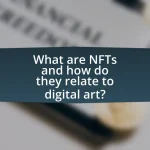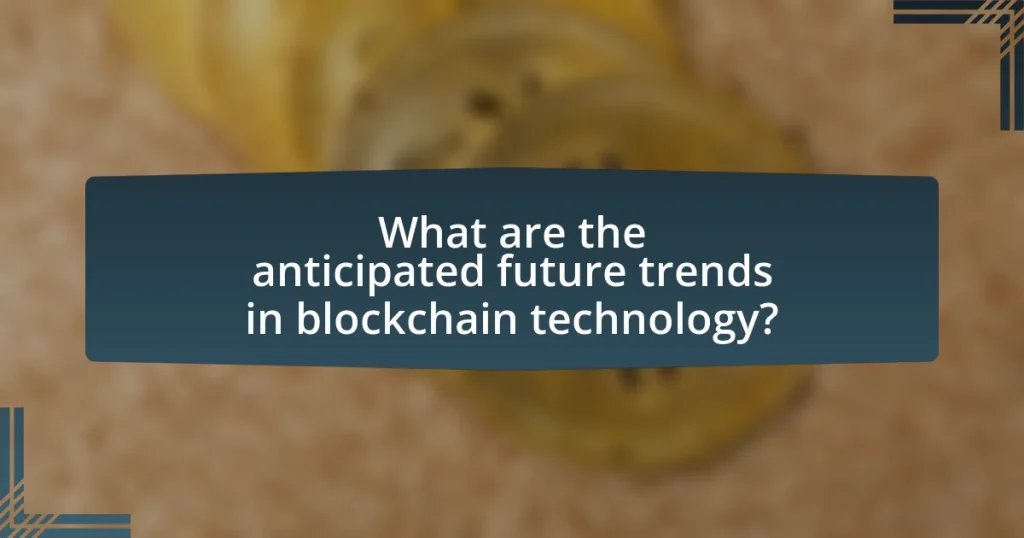The article focuses on the future trends in blockchain technology, highlighting anticipated developments over the next decade. Key areas of growth include the increased adoption of decentralized finance (DeFi), enhanced interoperability among blockchain networks, and the integration of blockchain with emerging technologies such as artificial intelligence and the Internet of Things (IoT). The article also discusses how scalability issues will be addressed, the transformative impact of blockchain on various industries like finance, supply chain, and healthcare, and the crucial role of regulation in shaping its future. Additionally, it examines user experience improvements, potential risks, and best practices for businesses preparing for blockchain adoption.

What are the anticipated future trends in blockchain technology?
Anticipated future trends in blockchain technology include increased adoption of decentralized finance (DeFi), enhanced interoperability between different blockchain networks, and the integration of blockchain with emerging technologies like artificial intelligence and the Internet of Things (IoT). DeFi is expected to grow significantly, with a report from the World Economic Forum predicting that by 2025, 10% of global GDP could be stored on blockchain technology. Interoperability will facilitate seamless transactions across various platforms, addressing current limitations. Additionally, the convergence of blockchain with AI and IoT will enable smarter contracts and more efficient data management, as highlighted in a study by Deloitte, which emphasizes the potential for blockchain to enhance data security and transparency in these fields.
How will blockchain technology evolve in the next decade?
Blockchain technology will evolve significantly in the next decade through increased scalability, interoperability, and regulatory integration. Innovations such as sharding and layer-2 solutions will enhance transaction speeds and reduce costs, addressing current scalability issues. Interoperability protocols will enable different blockchain networks to communicate, fostering a more connected ecosystem. Additionally, as governments and organizations establish clearer regulations, blockchain will gain wider acceptance in various sectors, including finance, supply chain, and healthcare. These advancements will be driven by ongoing research and development, as well as growing demand for secure and transparent systems.
What technological advancements are expected to influence blockchain?
Technological advancements expected to influence blockchain include improvements in scalability, interoperability, and privacy. Scalability enhancements, such as sharding and layer-2 solutions like the Lightning Network, aim to increase transaction throughput and reduce latency. Interoperability advancements, facilitated by protocols like Polkadot and Cosmos, enable different blockchains to communicate and share data seamlessly. Privacy improvements, driven by technologies like zero-knowledge proofs and confidential transactions, enhance user anonymity and data protection. These advancements are crucial for addressing current limitations and expanding blockchain applications across various industries.
How will scalability issues be addressed in future blockchain systems?
Scalability issues in future blockchain systems will be addressed through various technological advancements, including sharding, layer-2 solutions, and improved consensus mechanisms. Sharding divides the blockchain into smaller, manageable pieces, allowing for parallel processing of transactions, which significantly increases throughput. Layer-2 solutions, such as the Lightning Network for Bitcoin and zk-Rollups for Ethereum, enable off-chain transactions that reduce the load on the main blockchain while maintaining security. Additionally, new consensus mechanisms like Proof of Stake and Delegated Proof of Stake are being developed to enhance transaction speeds and reduce energy consumption compared to traditional Proof of Work systems. These approaches are supported by ongoing research and development in the blockchain community, demonstrating a commitment to overcoming scalability challenges.
What industries are likely to be transformed by blockchain technology?
Blockchain technology is likely to transform industries such as finance, supply chain management, healthcare, real estate, and entertainment. In finance, blockchain enables secure and transparent transactions, reducing fraud and improving efficiency, as evidenced by the rise of cryptocurrencies and decentralized finance platforms. Supply chain management benefits from enhanced traceability and accountability, with companies like IBM and Walmart utilizing blockchain to track products from origin to consumer. In healthcare, blockchain can securely store patient records, ensuring privacy and interoperability, as demonstrated by initiatives like MedRec. Real estate transactions can become more efficient through smart contracts, reducing the need for intermediaries, while the entertainment industry can leverage blockchain for copyright protection and fair revenue distribution, as seen with platforms like Audius. These examples illustrate the significant potential of blockchain technology to reshape these industries.
Which sectors will see the most significant adoption of blockchain?
The sectors that will see the most significant adoption of blockchain include finance, supply chain management, healthcare, and real estate. In finance, blockchain enhances security and transparency in transactions, with over 80% of financial institutions exploring blockchain solutions according to a Deloitte survey. Supply chain management benefits from improved traceability and efficiency, as evidenced by Walmart’s use of blockchain to track food products, reducing the time to trace produce from six days to mere seconds. In healthcare, blockchain can secure patient data and streamline processes, with studies indicating that 55% of healthcare executives believe blockchain will be critical for their organizations. Real estate is also adopting blockchain for property transactions, with platforms like Propy facilitating cross-border real estate deals using smart contracts.
How will blockchain impact supply chain management?
Blockchain will significantly enhance supply chain management by providing increased transparency, traceability, and efficiency. This technology allows all parties involved in the supply chain to access a single, immutable ledger that records every transaction, thereby reducing fraud and errors. For instance, a study by the World Economic Forum indicates that blockchain could reduce supply chain-related costs by up to 20% through improved visibility and streamlined processes. Additionally, companies like IBM and Maersk have successfully implemented blockchain solutions to track shipments in real-time, demonstrating its practical benefits in enhancing operational efficiency and accountability.
What role will regulation play in the future of blockchain technology?
Regulation will play a crucial role in shaping the future of blockchain technology by establishing legal frameworks that ensure security, transparency, and compliance. As blockchain applications expand across industries, regulatory bodies will likely implement guidelines to address issues such as fraud, money laundering, and consumer protection. For instance, the Financial Action Task Force (FATF) has already recommended that countries regulate cryptocurrency exchanges to prevent illicit activities, indicating a trend toward increased oversight. This regulatory environment will foster trust among users and investors, ultimately driving broader adoption and innovation within the blockchain ecosystem.
How might governments shape blockchain development?
Governments can shape blockchain development through regulation, funding, and collaboration with private sectors. By establishing clear regulatory frameworks, governments can create an environment that fosters innovation while ensuring compliance with legal standards. For instance, countries like Switzerland have implemented favorable regulations that attract blockchain startups, demonstrating how supportive policies can stimulate growth in the sector. Additionally, government funding for blockchain research and development can accelerate technological advancements, as seen in initiatives like the European Union’s Horizon 2020 program, which allocated significant resources to blockchain projects. Furthermore, partnerships between governments and private companies can lead to the development of public blockchain applications, enhancing transparency and efficiency in public services.
What are the potential challenges posed by regulatory frameworks?
Regulatory frameworks pose several potential challenges, including compliance costs, legal uncertainties, and stifling innovation. Compliance costs can be significant, as organizations may need to invest in legal expertise and technology to meet regulatory requirements, which can divert resources from core business activities. Legal uncertainties arise when regulations are ambiguous or inconsistent across jurisdictions, leading to confusion and potential non-compliance. Furthermore, overly stringent regulations can stifle innovation by creating barriers to entry for new players in the blockchain space, ultimately hindering technological advancement and market growth.

How will user experience change with advancements in blockchain?
User experience will improve significantly with advancements in blockchain through enhanced security, faster transactions, and greater transparency. As blockchain technology evolves, users will benefit from decentralized applications that offer seamless interactions without intermediaries, reducing the risk of fraud and data breaches. For instance, the implementation of smart contracts automates processes, ensuring that transactions are executed automatically when conditions are met, which streamlines user engagement. Additionally, advancements in blockchain scalability will lead to quicker transaction times, making it more efficient for users to conduct business. According to a report by the World Economic Forum, by 2025, 10% of global GDP is expected to be stored on blockchain, indicating a shift towards more integrated and user-friendly blockchain solutions.
What improvements can users expect in blockchain interfaces?
Users can expect significant improvements in blockchain interfaces, including enhanced user experience, increased accessibility, and better integration with existing technologies. These advancements will likely feature intuitive designs that simplify navigation and transaction processes, making blockchain technology more user-friendly for individuals with varying levels of technical expertise. Additionally, the incorporation of advanced security measures, such as biometric authentication and multi-factor authentication, will bolster user confidence in utilizing blockchain applications. Research indicates that as blockchain technology matures, platforms will increasingly adopt standardized protocols, facilitating seamless interoperability between different blockchain networks, which will further enhance user engagement and functionality.
How will user accessibility be enhanced in blockchain applications?
User accessibility in blockchain applications will be enhanced through the development of user-friendly interfaces and simplified onboarding processes. These improvements will include intuitive design elements that cater to non-technical users, making it easier to navigate blockchain functionalities. Additionally, the integration of mobile applications and wallet solutions will facilitate easier access to blockchain services, allowing users to interact with decentralized applications seamlessly. Research indicates that as of 2023, over 60% of blockchain projects are prioritizing user experience enhancements, reflecting a significant trend towards making blockchain technology more accessible to a broader audience.
What role will education play in improving user experience with blockchain?
Education will play a crucial role in improving user experience with blockchain by enhancing understanding and accessibility of the technology. As users become more educated about blockchain concepts, they will be better equipped to navigate platforms, utilize applications, and engage in transactions securely. Research indicates that increased knowledge leads to higher confidence levels among users, which can reduce the fear of making mistakes and enhance overall satisfaction. For instance, a study by the World Economic Forum highlights that educational initiatives can demystify blockchain, making it more approachable for non-technical users, thereby fostering broader adoption and improved user experiences.
How will interoperability between blockchains evolve?
Interoperability between blockchains will evolve through the development of standardized protocols and cross-chain communication technologies. As the blockchain ecosystem matures, projects like Polkadot and Cosmos are leading the way by enabling different blockchains to communicate and share data seamlessly. These advancements will facilitate greater collaboration among decentralized applications and enhance the overall functionality of blockchain networks. The increasing demand for interoperability is evidenced by the growing number of decentralized finance (DeFi) platforms that require cross-chain capabilities to optimize liquidity and user experience.
What are the benefits of cross-chain communication?
Cross-chain communication enables different blockchain networks to interact and share data, enhancing interoperability. This interoperability allows for the seamless transfer of assets and information across diverse platforms, which can lead to increased liquidity and broader market access. Additionally, cross-chain communication can foster innovation by enabling developers to create decentralized applications that leverage the strengths of multiple blockchains, thus expanding functionality and user engagement. Furthermore, it can enhance security by distributing risk across various networks, reducing the likelihood of single points of failure.
How will interoperability affect the overall blockchain ecosystem?
Interoperability will significantly enhance the overall blockchain ecosystem by enabling seamless communication and data exchange between different blockchain networks. This capability allows for greater collaboration, resource sharing, and the creation of more complex decentralized applications that leverage the strengths of multiple blockchains. For instance, projects like Polkadot and Cosmos are already demonstrating how interoperability can facilitate cross-chain transactions and interactions, thereby increasing liquidity and user engagement across platforms. As a result, the blockchain ecosystem will become more integrated, fostering innovation and expanding the potential use cases for blockchain technology.

What are the potential risks and challenges facing blockchain technology?
The potential risks and challenges facing blockchain technology include scalability issues, regulatory uncertainty, security vulnerabilities, and energy consumption. Scalability remains a significant challenge as many blockchain networks struggle to handle a high volume of transactions efficiently; for instance, Bitcoin can process only about seven transactions per second, compared to thousands for traditional payment systems. Regulatory uncertainty poses risks as governments worldwide grapple with how to regulate blockchain and cryptocurrencies, leading to potential legal complications for users and developers. Security vulnerabilities, such as smart contract bugs and 51% attacks, can compromise the integrity of blockchain networks; the DAO hack in 2016, which resulted in a loss of $60 million, exemplifies this risk. Lastly, the energy consumption associated with proof-of-work consensus mechanisms raises environmental concerns, with Bitcoin mining alone estimated to consume more energy than some countries.
What security concerns should be addressed in future blockchain systems?
Future blockchain systems should address concerns related to scalability, privacy, and smart contract vulnerabilities. Scalability issues arise as transaction volumes increase, potentially leading to slower processing times and higher fees, which can hinder user adoption. Privacy concerns stem from the transparent nature of blockchain, where sensitive data can be exposed; implementing advanced cryptographic techniques can mitigate this risk. Additionally, smart contracts are susceptible to coding errors and exploits, necessitating rigorous testing and auditing processes to ensure their security. Addressing these concerns is crucial for the widespread acceptance and reliability of blockchain technology in the coming decade.
How can blockchain networks protect against cyber threats?
Blockchain networks protect against cyber threats through decentralization, cryptographic security, and consensus mechanisms. Decentralization reduces the risk of a single point of failure, making it difficult for attackers to compromise the entire network. Cryptographic techniques, such as hashing and digital signatures, ensure data integrity and authenticity, preventing unauthorized access and tampering. Consensus mechanisms, like Proof of Work or Proof of Stake, require agreement among network participants before transactions are validated, which adds an additional layer of security against fraudulent activities. These features collectively enhance the resilience of blockchain networks against various cyber threats, including data breaches and denial-of-service attacks.
What measures can be taken to enhance data privacy in blockchain?
To enhance data privacy in blockchain, implementing advanced cryptographic techniques is essential. Techniques such as zero-knowledge proofs allow one party to prove to another that a statement is true without revealing any additional information, thereby maintaining privacy. Additionally, utilizing privacy-focused blockchain protocols like Monero or Zcash, which incorporate features such as ring signatures and zk-SNARKs, can significantly improve transaction confidentiality. Furthermore, employing off-chain solutions, where sensitive data is stored outside the blockchain while maintaining a secure link to it, can also bolster privacy. These measures collectively contribute to a more secure and private blockchain environment.
How might public perception of blockchain change over the next decade?
Public perception of blockchain is likely to evolve towards greater acceptance and understanding over the next decade. As more industries adopt blockchain technology for transparency, security, and efficiency, public awareness will increase, leading to a more informed perspective. For instance, a 2021 survey by Deloitte indicated that 76% of executives believe blockchain will be a critical part of their business strategy within the next two years, suggesting a growing recognition of its value. Additionally, as regulatory frameworks develop and successful use cases emerge, skepticism may diminish, fostering trust in blockchain applications.
What factors influence public trust in blockchain technology?
Public trust in blockchain technology is influenced by factors such as transparency, security, regulatory frameworks, and user education. Transparency in blockchain systems allows users to verify transactions independently, fostering confidence. Security is critical, as robust cryptographic measures protect data integrity and prevent fraud, which enhances trust. Regulatory frameworks provide legal clarity and protection for users, making them more likely to engage with blockchain solutions. Lastly, user education about how blockchain works and its benefits can demystify the technology, leading to increased acceptance and trust among the public.
How can successful case studies improve blockchain’s reputation?
Successful case studies can significantly improve blockchain’s reputation by demonstrating its practical applications and benefits in real-world scenarios. When organizations showcase successful implementations of blockchain technology, such as supply chain transparency or secure financial transactions, they provide tangible evidence of its effectiveness. For instance, IBM’s Food Trust blockchain has enhanced traceability in the food supply chain, reducing waste and increasing consumer trust. Such examples not only validate blockchain’s capabilities but also counteract skepticism by illustrating its reliability and potential for positive impact across various industries.
What practical steps can businesses take to prepare for blockchain’s future?
Businesses can prepare for blockchain’s future by investing in education and training for their workforce on blockchain technology. This foundational knowledge enables employees to understand the implications and applications of blockchain, fostering innovation within the organization. Additionally, companies should explore partnerships with blockchain startups and technology providers to gain insights and access to cutting-edge solutions. Implementing pilot projects can also help businesses test blockchain applications in a controlled environment, allowing them to evaluate potential benefits and challenges. Furthermore, staying informed about regulatory developments and industry standards is crucial, as compliance will play a significant role in successful blockchain adoption. According to a report by Deloitte, 40% of organizations are already exploring blockchain solutions, highlighting the urgency for businesses to act proactively in this evolving landscape.
How can organizations assess their readiness for blockchain adoption?
Organizations can assess their readiness for blockchain adoption by conducting a comprehensive evaluation of their current technological infrastructure, business processes, and strategic goals. This assessment should include analyzing existing data management systems, identifying potential use cases for blockchain, and evaluating the organization’s capacity for change management.
Furthermore, organizations should consider their workforce’s skill set, as successful blockchain implementation often requires specialized knowledge in areas such as cryptography and distributed ledger technology. According to a report by Deloitte, 39% of organizations cited a lack of skilled personnel as a significant barrier to blockchain adoption, highlighting the importance of workforce readiness.
Additionally, organizations should engage in stakeholder consultations to gauge interest and support for blockchain initiatives, ensuring alignment with business objectives. By systematically addressing these factors, organizations can effectively determine their readiness for blockchain adoption.
What best practices should businesses follow when implementing blockchain solutions?
Businesses should follow several best practices when implementing blockchain solutions, including conducting thorough research, defining clear objectives, ensuring regulatory compliance, and prioritizing security. Thorough research allows businesses to understand the technology’s capabilities and limitations, while defining clear objectives helps in aligning blockchain applications with business goals. Regulatory compliance is crucial, as blockchain operates in a complex legal landscape, and prioritizing security protects sensitive data and maintains trust among stakeholders. These practices are essential for successful blockchain integration and can significantly enhance operational efficiency and transparency.










